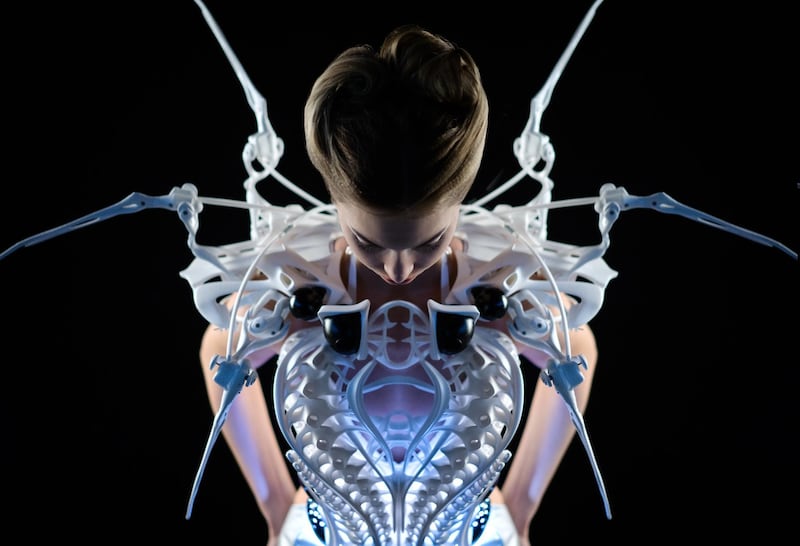Wearable tech is one of the big buzzwords in fashion at the moment. Constantly evolving, the application of technology to clothing and jewellery has already resulted in bracelets that count steps, watches that read emails and handbags that can charge a mobile phone.
So it is probably no surprise that the next stage is clothing that actively responds to the person wearing it. Enter Anouk Wipprecht, a Dutch entrepreneur and designer who is quietly changing how people and technology interact. As an innovator, designer, creator and collaborator, Wipprecht has worked with brands such as Microsoft, Swarovski, Adidas, as well as Cirque du Soleil, the Super Bowl, Disney and even Britney Spears.
So what does she do, exactly? Using cutting-edge tech and a vivid imagination, she creates systems that work in direct response to the human body, in what she describes as "wearable couture" and "fashion as interface". Seemingly fascinated by the application of technology to the everyday, she has, for example, created the 3-D-printed Spider Dress, which features embedded sensors that monitor the space around the wearer, activating moveable arms to push away anyone who gets too close. The Pseudomorphs neck pieces, meanwhile, release ink via pneumatic control valves onto dresses, creating unique designs. The Smoke Dress, created in collaboration with Niccolo Casas, automatically creates a veil of smoke around the wearer, while the Synapse Dress gathers data from the wearer's brain. This may sound like the stuff of science fiction, but by looking at the very real possibilities of how technology can enhance our lives – she is adamant it must enhance, not control – Wipprecht is initiating approaches that may one day impact us all. She will be in Dubai sharing some of those insights on December 16, as part of the Echo festival of art, design and technology. We caught up with her to find out more.
The universes of technology and fashion seem to be very far apart. What first inspired you to combine them?
In the beginning of 2000, I saw technology crawling closer to the skin and realised fashion could function as a new kind of interface, connected to the body. Fashion for me was about expression and communication, and technology could bring it from an analog – normal garments – to a digital, electronic and interactive notion – electronic garments – that could act on your behalf. This was fascinating for me and I started researching these different kinds of body-worn interactions and what they could mean for us.
. Why is this mix Your Spider Dress is both beautiful and aggressiveintriguing for you?
The Spider Dress has something moody to it – a dress with mechanical spider legs on the shoulders equipped with proximity sensors. When you come into the personal space of the wearer, this dress attacks you, very literally, as the robotic system is grabbing out to get you. For me this is a statement dress – a dress that protects us to a certain degree by considering our personal space, and acts to defend us.
How are the body pieces made? What is the process?
I use a combination of 3-D modelling, architecture, design, circuit-building, programming, engineering, sewing and soldering. It’s a very fun process building these designs (I have 37 dresses in total at the moment) and they are all based on microcontrollers and sets of sensors. For me, the microcontrollers are the brain and the heartbeat of my designs, as they create the interactions and reactions towards the world.
Often 3-D printed, or with 3-D printed elements, they are a combination of architecture, design and robotics.
Your designs suggest a preoccupation with emotions and stress levels. Is that the case?
Technology came into our lives to help us, but at the moment it is more a compass for stress. When I open my mobile phone, I almost get a heart attack from the number of messages that I need to respond to. Our society has become heavy and fast, and our current technologies don’t really take us into consideration. Body-worn interfaces and fashion tech have the ability to sense us, and listen to our bodies. This is why I am interested in it. Fashion as interface.
The pieces are a blend of high-tech thinking and almost retro designs – one piece looks as if it is crochet. Is this a conscious blurring of lines?
Yes. My Smoke Dress – a dress equipped with sensors that starts to surround itself with a smoke screen the more people are around – is an example of a more poetic and friendly design. It is pear-shaped and looks very organic and, also, the interaction is very organic, too: a soft layer of smoke fills the immediate surroundings of the dress when the system is triggered.
The Spider Dress is a bit more eerie: it gives you an almost psychological thrill when you look at it and and also when you interact with it. This is important for me – that the design informs the interaction.
_______________
Read more:
[ Meghan Markle sets style bar with elegant engagement outfit ]
Victoria Beckham launches limited-edition make-up line
[ Colette to bow out after one last collaboration ]
_______________





